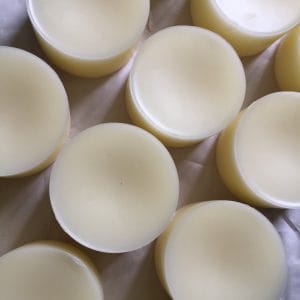
With the continuing drive to reduce single use plastic, solid conditioner bars have become more and more popular in recent months. I started experimenting with mine sometime last year, but the development / certification process can be a long one, and it wasn’t until the 2nd of October that I received the *Cosmetic Product Safety Assessment (CPSR) which meant I could finally offer solid conditioner bars to the public (and you can be sure that they’re perfectly safe to use)
So what are they made of?
Here’s the full ingredients list for the unscented version. Beneath I’ll give the same list in plain English.
BTMS25 (Behentrimonium Methosulfate, Cetearyl Alcohol), Cetyl Alcohol, Cocos Nucifera (Coconut) Oil, Simmondsia Chinensis (Jojoba) Seed Oil, Glycerin, Butyrospermum Parkii (Shea) Butter, Phenoxyethanol,
Plain English:
BTMS25 (Behentrimonium Methosulfate, Cetearyl Alcohol), Cetyl Alcohol, Coconut Oil, Jojoba Oil, Glycerin, Shea Butter, Preservative (Phenoxyethanol)
The chances are some of these ingredients will be unfamiliar to you. It’s possible that they might even ring alarm bells and I’m guessing that the ones that may cause concern are BTMS25 (Behentrimonium Methosulfate, Cetearyl Alcohol), Cetyl Alcohol and Preservative, so let me address these in turn.
1 Behentrimonium Methosulfate
Unfamiliar though this sounds, don’t be alarmed into lumping this sulfate with the ‘bad guys’ (eg sodium lauryl sulfate SLS) It’s a gentle surfectant, non irritating to the scalp, and one of the mildest (yet effective) detanglers, giving ‘slip’ to your hair after washing. Made from Rapeseed Oil.
2. Cetearyl Alcohol / Cetyl Alcohol
These are both fatty alcohols that occur naturally in plants and animals. I have been given a personal assurance from my supplier (The Soapery) that not only are the ones I use vegan friendly, they’re also palm free, being derived from coconut. They are used in conditioners for their emulsifying and moisturising properties.
3. Preservative (Phenoxyethanol)
Any solid conditioner MUST, by law, contain a preservative before it can be made available for sale. This is because once it comes into contact with water, there is the opportunity for bacterial, mould and yeast growth. Preservative or botulism? Regardless of the legalities, I know which I would choose. Phenoxyethanol has been called a ‘natural’ preservative, but this is a little misleading. It does appear in nature (in green tea, and chicory) but the one I use is a nature identical version created synthetically. It is free from parabens. This article gives a good, balanced overview of the use of Phenoxyethanol in cosmetic products.
The other ingredients (coconut and jojoba oils, shea butter and glycerin) are added for their moisturising properties.
I currently offer five varieties of the conditioner bars to match the shampoo bars: Unfragranced, Lemongrass & Spearmint, Tea Tree, Lavender & Sweet Orange and Mandarin & Bergamot. The ingredients are identical, other than the different essential oils ujsed to fragrance the bars.
*A CPSR is a legal requirement for ANY cosmetic / skin & body care product before it can be placed on the market in the European Union. Please make sure that any handmade product of this type has been certified before you make a purchase.

Hi Vicki:
Nice info/description of your conditioner bars – they look beautiful!
The note that CPSR is a legal requirement feels a bit misleading to me, as it is not a requirement in the USA – but maybe all of your blog followers are in the UK?
Question: I find my Conditioner Bars to be very expensive to make (I use BTMS-50 and Silk proteins in mine, which bumps up the price). What size are yours and what is the price difference compared to your soaps?
My 4 oz Conditioner bars are equal to about 1 liter of liquid conditioner, so I feel the higher price is justified, but would like your thoughts.
Thanks so much!
Sly
Hi Sly! You are perfectly right of course, I’ve amended the post to say that the CPSR is a requirement in the EU – thanks for pointing that out!
My first experiements into conditioner bars used BTMS50 and my bars proved to work out prohibitively expensive. I found BTMS25 to be a lot more affordable, while still giving the level of conditioning that I was after, especially after some work on the balance between emulsifyers and shea/jojoba oils. They weigh 60g, and I sell them for £6 (by comparison my 110/120g bars of soap sell for £4.50) but like yours they last for a very long time compared to a bottle of conditioner. I find, as I’m sure you do, especially using BTMS50, that they only need to be used very sparingly.
Great post – and very informative. And again, congratulations on receiving your assessment. Solid shampoo and conditioner bars are definitely becoming more popular. I haven’t perfected mine enough yet for assessment ( still struggling with the ridiculously hard water here ). x
Thank you! Hard water can definitely cause problems, I’m lucky that it’s very soft here but I always warn people who don’t live locally of the impact hard water could have.
[…] ← Previous […]
People in my area have no knowledge of the fact that shampoos that grow your hair fast (obviously with no sulfates, no parabens, no DEA) exist. People can now possess longer hair and enjoy more options. Certainly worth researching.
Whether you’re going over alopecia, hair damage, preventing hair disorders, hair growth, hair health at large, almost the same principles apply.
As a rule of thumb, you will want to stay away from hair products and treatments that contain chemicals such as parabens, DEA and sulfates.
What’s healthy for your hair is beneficial for your skin as well.
Obviously your content here is so accurate for multiple reasons. It steers away from the usual pitfalls and traps too many fall into- buying horrible alternatives. Thank you so much!
Thanks for your kind comments, very much appreciated 🙂